Applying Changes in T-FLEX DOCs |
  
|
A T-FLEX DOCs file should be checked out before editing. This makes possible collaborative product development and tracking of changes. If a user checks out a file, the file can not be edited by other users. If you open a file without checking it out, then you can save changes into other file only. After checking out a file and changing it, the changes can be either applied or canceled.
Check out for edit
A T-FLEX DOCs file can be checked out for editing in one of the following ways:
•Using the ![]() Check out for edit command, which is available in contextual menu of elements and in toolbar of the
Check out for edit command, which is available in contextual menu of elements and in toolbar of the ![]() Files dataset, as well as in file properties window. The <Ctrl>+<O> key combination can be used for calling this command only in T-FLEX DOCs windows. In order to edit checked out file, you will have to open it.
Files dataset, as well as in file properties window. The <Ctrl>+<O> key combination can be used for calling this command only in T-FLEX DOCs windows. In order to edit checked out file, you will have to open it.
Keep in mind, that the same command in the ![]() Product Structure dataset checks out only an object of this dataset, i.e. a record of DOCs product structure, without checking out a T-FLEX CAD attached to this record.
Product Structure dataset checks out only an object of this dataset, i.e. a record of DOCs product structure, without checking out a T-FLEX CAD attached to this record.
•Using the ![]() Open for edit command, which is available in contextual menu of elements of the
Open for edit command, which is available in contextual menu of elements of the ![]() Product Structure dataset. This command not only checks out an object, but also opens its file in T-FLEX CAD.
Product Structure dataset. This command not only checks out an object, but also opens its file in T-FLEX CAD.
•By giving a positive answer to the question asked upon opening a file.
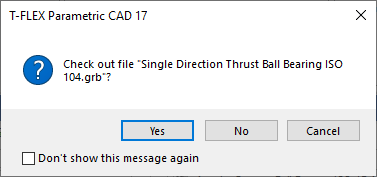
•By enabling the Check out for editing checkbox in the Open with Parameters dialog.
The dialog is invoked, when you drag an object from a DOCs window to any area within CAD window, except the drawing window and the 3D scene.
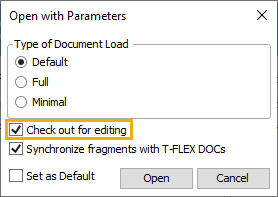
•If a T-FLEX DOCs file is opened in T-FLEX CAD without: checking it out, then it can be checked out using the following command:
Icon |
Ribbon |
|---|---|
|
T‑FLEX DOCs > Editing Documents > Check out for edit |
Keyboard |
Textual Menu |
|
|
If the file is already checked out by the current user or by some other user, then this command is not available.
Changes made in T-FLEX DOC object, can be applied using the ![]() Apply changes command:
Apply changes command:
Icon |
Ribbon |
|---|---|
|
T‑FLEX DOCs > Editing Documents > Apply changes |
Keyboard |
Textual Menu |
|
|
The command is also available in various windows of T-FLEX DOCs and in contextual menu of elements, that have not applied changes. The <Ctrl>+<I> key combination can be used for calling this command only in T-FLEX DOCs windows
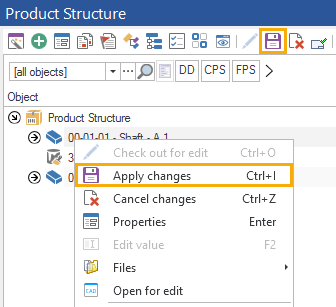
Upon calling this command, the Applying changes window of T-FLEX DOCs appears, where you should type in some Comments and press OK.
The object, which the command is called for, is displayed in the Selected Objects list in the upper left section of the window.
If the command is called from T-FLEX CAD ribbon or from the ![]() Files dataset window, then the changes are applied to the current file only. After applying changes the file remains open read-only.
Files dataset window, then the changes are applied to the current file only. After applying changes the file remains open read-only.
If the command is called from ![]() Product Structure dataset window, then, by default, changes are not applied to files attached to the selected object, but they are applied to linked objects of other dataset. Such linked objects are displayed in the Related objects list in the upper right section of the window.
Product Structure dataset window, then, by default, changes are not applied to files attached to the selected object, but they are applied to linked objects of other dataset. Such linked objects are displayed in the Related objects list in the upper right section of the window.
In order to apply changes to files attached to the selected object, use the Add Files button.
If the selected object has child objects in the hierarchy of the ![]() Product Structure dataset, you can use the the Add attachments button, in order to apply changes to child objects and their attached files.
Product Structure dataset, you can use the the Add attachments button, in order to apply changes to child objects and their attached files.
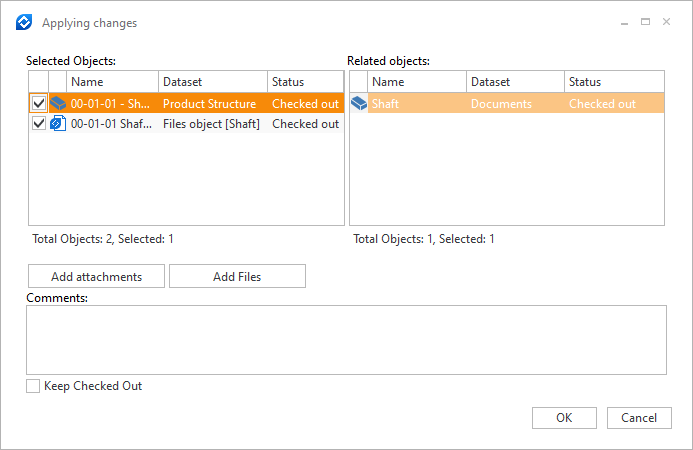
You can apply changes to all checked out objects at once, or to all objects of a particular dataset in the ![]() Checked out objects window.
Checked out objects window.
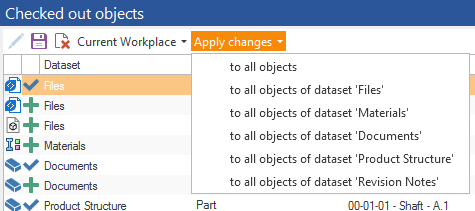
Changes made in a T-FLEX DOC object can be canceled using the following command:
Icon |
Ribbon |
|---|---|
|
T‑FLEX DOCs > Editing Documents > Cancel Changes |
Keyboard |
Textual Menu |
|
|
The command is also available in various windows of T-FLEX DOCs and in contextual menu of elements, that have not applied changes. The <Ctrl>+<Z> key combination can be used for calling this command only in T-FLEX DOCs windows
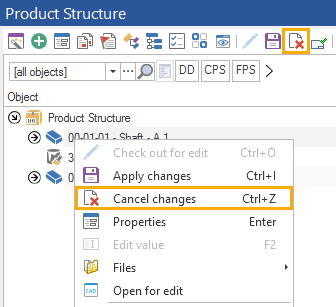
Upon calling the command, the system will ask for confirmation:
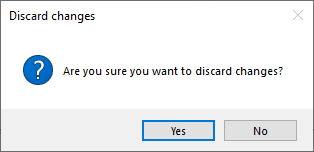
Positive answer leads to discarding all non-applied changes of the selected object. Calling the command from the T-FLEX CAD ribbon, cancels changes of the current file (including ones made in previous sessions) and the closes the file. Changes of objects linked to this file (e.g. object of DOCs product structure) are not canceled.